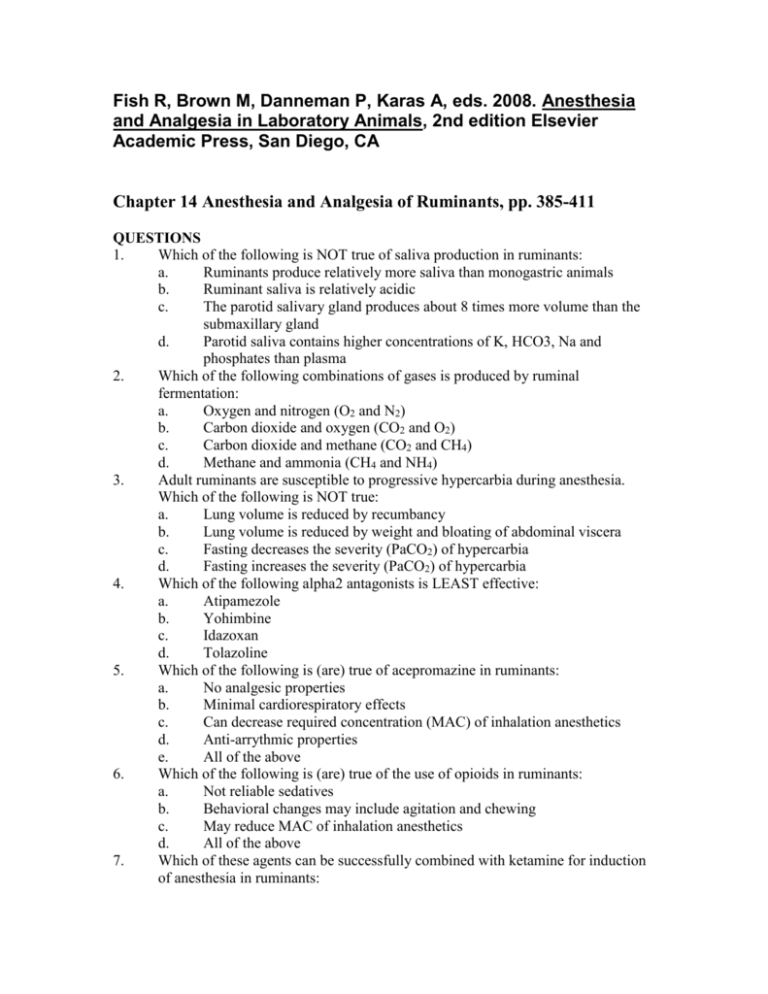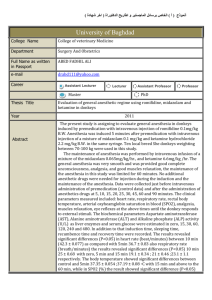Chapter 14
advertisement

Fish R, Brown M, Danneman P, Karas A, eds. 2008. Anesthesia and Analgesia in Laboratory Animals, 2nd edition Elsevier Academic Press, San Diego, CA Chapter 14 Anesthesia and Analgesia of Ruminants, pp. 385-411 QUESTIONS 1. Which of the following is NOT true of saliva production in ruminants: a. Ruminants produce relatively more saliva than monogastric animals b. Ruminant saliva is relatively acidic c. The parotid salivary gland produces about 8 times more volume than the submaxillary gland d. Parotid saliva contains higher concentrations of K, HCO3, Na and phosphates than plasma 2. Which of the following combinations of gases is produced by ruminal fermentation: a. Oxygen and nitrogen (O2 and N2) b. Carbon dioxide and oxygen (CO2 and O2) c. Carbon dioxide and methane (CO2 and CH4) d. Methane and ammonia (CH4 and NH4) 3. Adult ruminants are susceptible to progressive hypercarbia during anesthesia. Which of the following is NOT true: a. Lung volume is reduced by recumbancy b. Lung volume is reduced by weight and bloating of abdominal viscera c. Fasting decreases the severity (PaCO2) of hypercarbia d. Fasting increases the severity (PaCO2) of hypercarbia 4. Which of the following alpha2 antagonists is LEAST effective: a. Atipamezole b. Yohimbine c. Idazoxan d. Tolazoline 5. Which of the following is (are) true of acepromazine in ruminants: a. No analgesic properties b. Minimal cardiorespiratory effects c. Can decrease required concentration (MAC) of inhalation anesthetics d. Anti-arrythmic properties e. All of the above 6. Which of the following is (are) true of the use of opioids in ruminants: a. Not reliable sedatives b. Behavioral changes may include agitation and chewing c. May reduce MAC of inhalation anesthetics d. All of the above 7. Which of these agents can be successfully combined with ketamine for induction of anesthesia in ruminants: 8. 9. 10. 11. 12. 13. 14. 15. a. Xylazine b. Midazolam c. Diazepam d. All of the above Guaifenesin can be added to an anesthestic induction regime to provide additional a. Sedation b. Analgesia c. Muscle relaxation d. All of the above Direct visualization of the larynx in adult cattle is obstructed by the: a. Soft palate b. Torus linguae c. Palatine tonsils All inhalant anesthetic agents cause a dose-dependant a. Decrease in cardiac output and stroke volume b. Decrease in respiratory rate and tidal volume c. Decrease in blood pressure d. All of the above Which of the following body systems is most sensitive to lidocaine toxicity? a. Central nervous system b, Cardiovascular c. Respiratory d. Gastro-intestinal A posterior epidural injection of lidocaine (sacrococcygeal or intercoccygeal space) provides regional anesthesia to the a. Tail and perineum b. Rear legs c. Udder or scrotum d. All of the above For which of these procedures would an auriculopalpebral nerve block be effective in cattle? a. Examination of the eye b. Enucleation of the eye c. Dehorning d. All of the above Which of the following nerves should be blocked for effective local anesthesia of the horn in cattle, sheep and goats: a. Cornual branch of the zygomatico-temporal nerve b. Cornual branch of the infratrochlear nerve c. Auriculo-temporal nerve d. A&B Intraoperative hypotension in large animals has been associated with: a. Post-operative myopathy b. Cerebral infarcts c. Pulmonary empolism d. All of the above 16. 17. 18. 19. 20. 21. 22. 23. 24. 25. 26. 27. 28. 29. 30. 31. 32. 33. 34. 35. 36. True or False: The ruminant stomach in an adult ruminant animal represents 49% of the wet tissue mass of the total gastrointestinal tract and 25 – 35% of total body mass. True or False::Administration of anticholinergics (e.g. atropine) is indicated to reduce salivary production during anesthesia True or False: Ruminants are not considered to be capable of true vomiting, however, during anesthesia, ruminal contents can flow towards the oral cavity due to loss of cardiac and esophageal sphincter control. True or False: Anesthetic drugs in general have a stimulatory effect on rumination at sedative or anesthetic doses. True or False: The recommended preanesthetic fast is up to 48 hours for adult cattle and up to 24 hours for sheep and goats. True or False: Young calves (< 6 weeks of age) are essentially monogastric animals. True or False: It is important to note the location of the right cranial lobe bronchus in order to avoid obstructing ventilation to this lobe by placement of the endotracheal tube. True or False: Veins commonly used for intravenous drug administration in ruminants include the jugular, the auricular, and the saphenous veins. True or False: Ruminant animals are much more sensitive to the sedative effects of xylazine than most other species. True or False: Alpha2 agonists can cause hypoxemia and pulmonary edema in sheep. True or False:: Alpha2 agonists should be used with caution in ruminants in the final trimester of pregnancy due to increases in myometrial tone and decreases in uterine blood flow. True or False: Benzodiazepines are contraindicated in adult cattle because of the initial excitement phase. True or False: Benzodiazepines can be reversed with flumazenil or sarmazenil. True or False: The analgesic and apneic effects of ketamine are both due to its inhibitory effect on the N-methyl-D aspartate (NMDA) receptor. True or False: Ketamine should not be used as the sole agent for induction of anesthesia in an unsedated animal. True or False: Intubation of adult cattle should ideally be done in lateral recumbancy. True or False: Halothane’s increased solubility in fat (relative to isoflurane and sevoflurane) results in longer induction and recovery times. True or False: Nitrous oxide is recommended as an adjunct for inhalation anesthesia in ruminants. True or False: Intravenous ketamine or lidocaine can be used to reduce the MAC of inhalation anesthetic gases in ruminants. True or False: A four-point retrobulbar nerve block may be used to perform an enucleation in an adult cow. True or False: General anesthesia with ketamine/xylazine is recommended for disbudding of goat kids. 37. 38. 39. 40. True or False: palpebral reflex and rotation of the eye are useful in monitoring depth of anesthesia in ruminant. True or False: End-tidal CO2 values generally over-estimate true PaCO2. True or False: Opioids or alpha2 agonists delivered epidurally to cattle provide effective analgesia to the perineum, hindlimbs and abdomen. True or False: Phenylbutazone is recommended as an analgesic in adult dairy cattle. ANSWERS 1. B 2. C 3. C 4. B 5. E 6. D 7. D 8. C 9. B 10. D 11. A 12. A 13. A 14. D 15. A 16. T 17. F 18. T 19. F 20. T 21. T 22. T 23. F 24. T 25. T 26). 27. T 28. T 29. T 30. T 31. F 32. T 33. F 34. T 35. T 36. T 37. T 38. 39. 40. F F F






